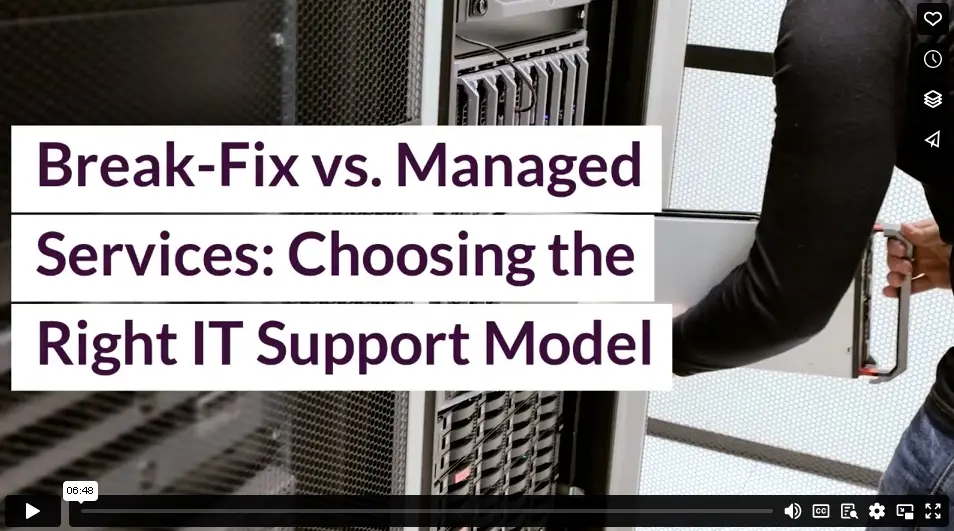Choosing between break-fix and managed IT services can feel like picking between apples and oranges. In break-fix, you get call support only when something breaks, and they fix it. In managed IT services, you have ongoing, proactive support to prevent issues before they happen. Both models aim to keep your IT running smoothly, but which one fits your needs best? Let’s find out by exploring their similarities and differences.
Break-Fix IT Support Overview
Break-fix IT support means you pay only when something breaks and needs fixing. For instance, if your server crashes, you call in business IT support services to resolve the issue and pay for their time.
Key things to know about break-fix services:
- You get billed by the hour for specific tasks like troubleshooting. There are no regular monthly charges.
- Support is on-demand, tackling immediate problems like system failures.
- It’s reactive, with no regular monitoring or maintenance to prevent issues.
- There’s little to no tech strategy or planning involved—just quick fixes.
- It’s good for simple tasks like upgrading memory or fixing a PC that don’t require ongoing management.
- Though it seems cost-effective at first, break-fix often lacks comprehensive tech guidance.
- Hourly rates can be higher compared to managed services.
Managed IT Services Overview
Managed IT services mean your provider keeps an eye on your tech 24/7, fixing and improving things before they break. You pay a set fee each month for ongoing support and maintenance. Here’s what managed services usually include:
- Routine checkups, updates, and performance boosts to keep everything running smoothly
- Time with IT experts work to plan upgrades, cybersecurity measures, and cloud solutions
- Spotting and fixing minor problems early to prevent bigger issues later
- Continuous partnership and advice to align tech improvements with your business goals
Note that although there’s a monthly fee, proactive care and strategic advice can save money in the long run compared to dealing with unexpected breakdowns.
Break-Fix vs. Managed Services: Comparing the Models
Despite both models offering IT support, there are key differences between break-fix and managed services. Here are some factors where they diverge:
1. Cost Structure
Break-fix requires you to pay only when something breaks. While this might seem cheaper initially, unexpected issues can raise your overall expenses significantly. Managed services, on the other hand, have a steady monthly fee—covering maintenance and support. This predictable cost helps prevent unexpected expenses and allows for better financial planning.
2. Business Impact
If your business doesn’t rely heavily on IT, break-fix might work. It’s suitable for less critical IT needs where occasional support suffices. For tech-dependent businesses that require constant system uptime, managed IT provides the attention and ongoing maintenance needed to keep operations running smoothly.
3. Nature of Service
The break-fix IT support model is reactive in nature. It only steps in when something goes wrong and needs fixing. Managed IT services offer proactive support and maintenance. If a company, for instance, feels its cybersecurity posture isn’t strong enough, it can count on its MSP partner to bring it up to par.
4. Scalability
As your business grows, so do your IT needs. Break-fix might not keep up with your increasing support demands. Managed services scale with you, providing the necessary support and infrastructure. They ensure your IT systems are robust enough to support your growth.
5. Security
Break-fix addresses security problems as they arise, leaving potential gaps in protection. Managed services continuously monitor and implement security measures, reducing the risk of data breaches and cyber threats. Proactive security helps protect your business from potential vulnerabilities.
6. Strategic Alignment
Managed services align IT with your business goals. They plan and implement IT solutions that drive your objectives, acting as a partner and understanding your business needs. Break-fix focuses only on immediate problems, whereas managed services contribute significantly to your long-term success.
Choosing Between Break-Fix and Managed Services
Company Size
The size of a company affects which IT support model works best. Small businesses with basic IT needs might find break-fix more practical. They often don’t have the budget for a monthly fee and don’t need constant IT monitoring. Larger businesses with complex IT needs can’t afford downtime. As such, they benefit more from managed IT support, which comes with continuous monitoring and maintenance.
Reliance on IT in Operations
How crucial IT is to a company’s daily operations also influences the choice between break-fix and managed services. Businesses that can tolerate some downtime without major disruptions might find break-fix adequate for their needs. Conversely, for companies where IT is integral to operations, such as law firms, medical practices, and financial services, managed services are essential. These businesses rely on continuous system uptime, and managed services ensure constant monitoring and proactive maintenance to prevent downtime.
Access to Expertise and Resources
The level of expertise and resources required is another important factor. Businesses that employ IT experts may only need IT support when faced with complex or emergent issues. In contrast, managed services provide ongoing access to a wide range of expertise and advanced resources, making them beneficial for companies without extensive in-house IT staff.
Budgeting and Financial Planning
Money also matters when picking between break-fix and managed services. Managed services have a set monthly fee, making it easy to budget. This is good for businesses that like predictable costs. Break-fix might appeal to those with uneven cash flows since you pay only when needed. But remember, unexpected issues can lead to high costs with this model.
IT Infrastructure Complexity
Your IT setup’s complexity affects your choice. If your business uses basic systems, like simple computer networks, break-fix might be enough. But if you have multiple servers or rely on cloud services, managed services are better. Complex systems need regular checks and proactive care to avoid significant problems that can halt operations.
Making The Decision
Managed IT services are often a better option. Even if you’re a small business, you can benefit from proactive support to keep things running smoothly. Consider looking for a managed service provider near you to ensure continuous operation and long-term improvements for your business.
Video
Infographic
Deciding between break-fix and managed IT services can feel like choosing between apples and oranges. Both models aim to keep your IT running smoothly. Find out how to choose in this infographic.





